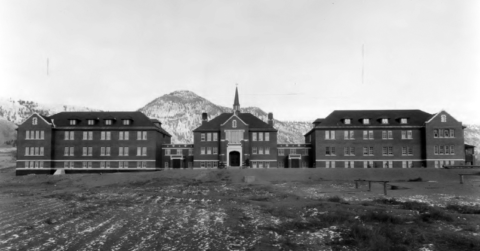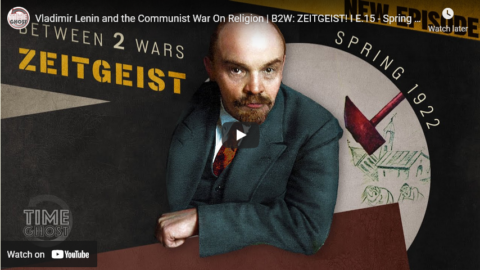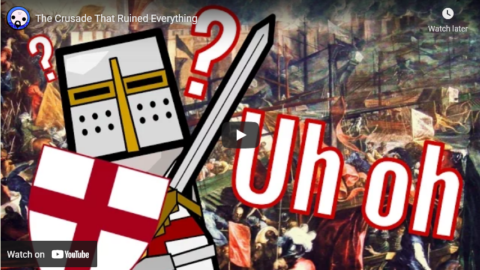Overly Sarcastic Productions
Published 10 Jun 2017It’s all coming together now. With the individual histories of Islam, Christianity, and Judaism covered, Blue puts it together to summarize how the three interacted in the centuries leading up to the Crusades. The next video will cover the Crusades. Hype.
RELEVANT LINKS:
History Summarized: Islam: https://youtu.be/Uvq59FPgx88
History Summarized: Christianity: https://youtu.be/A86fIELxFds
History Summarized: Judaism: https://youtu.be/aKB6WduDwNEHistory Summarized: The Crusades: https://youtu.be/wZhyDIIkeLo
History Summarized: Abrahamic Religious Philosophy: https://youtu.be/B7myRRt0Mn8PATREON: www.patreon.com/user?u=4664797
MERCH LINKS:
Shirts – https://overlysarcasticproducts.threa…
All the other stuff – http://www.cafepress.com/OverlySarcas…
July 20, 2021
History Summarized: Christianity, Judaism, and the Muslim Conquest
July 7, 2021
The “Squirrel!” distractions will end when it’s convenient for certain people and groups
Jay Currie considers the constant barrage of distractions that appear to be preventing most people from noticing what is actually going on in Canada:

Kamloops Indian Residential School, 1930.
Photo from Archives Deschâtelets-NDC, Richelieu via Wikimedia Commons.
The remarkable thing about all of these little snippets of news is that they seem to be regarded as business as usual. Being taxed by an inflation rate which is well into the double digits does not cut through the COVID hype. Vandalism and arson purportedly in rage over residential school deaths which we have known about for decades attracts very little comment – though many First Nations people are not very happy that reservation churches which have served their communities for years are being burnt. People seem to shrug off the heat wave deaths and ambulance delays.
I expect very little from government at any level. A reasonably sound currency, a degree of public order and emergency services which can deal with the inevitable surges in demand.
The emergency services issue is probably the most easily fixed. Yes, having more para-medics is part of the solution but planning a reponse to these sorts of surge emergencies which tries to avoid the need for an ambulance in the first place is important too. Most of the dead were old, in many cases, very old. It should not be impossible to identify those older people and have a plan for these sorts of emergencies. Something as simple as a “Helpful Neighbour” program on a voluntary basis would be a good first step.
Restoring public order is more complicated. First, you have to have the political will to actually take on the problem. As we saw a couple of years ago, when it comes to people purporting to act on behalf of First Nations/environmental causes that will is absent. But even if the politicians decided that enough was enough there needs to be an investigation and an understanding of how the “spontaneous” vandalism and arson and blockades are driven. That is going to require rooting around in the activist community which will be, to say the least, difficult. The people who are actually creating the public disorder pay close attention to operational and communications security. Suffice to say this stuff is not being organized on a Facebook page.
Restoring order is also going to require a look at who benefits from disorder. To take an example: was it co-incidence that the sad fact of the Kamloops residential school graveyard came up just as the inquiry into Canada’s Winnipeg Lab’s connection to the Wuhan virology lab was heating up? The fact of there being a graveyard had been know for decades. The ground radar was being used to determine the boundaries so a new fence could be built. Yet, somehow, the number of bodies became headline news. I suspect, but cannot prove, that this was no accident. Public order will be restored when disorder is no longer in anyone’s interest.
June 17, 2021
Canada’s most recent bout of mourning sickness
In Wednesday’s NP Platformed, Colby Cosh reports on a shocking incident in Dunnville, Ontario where a Catholic priest discovered and threw away some shoes that had been deposited on a bench in front of his church. This ***obviously*** was some sort of hate crime by the priest personally and the entire hierarchy of the Catholic church collectively all the way up to the Pope which must now be tearfully acknowledged and repented of in multiple media appearances, because the items were part of an informal, unofficial memorial to the long-deceased children whose unmarked graves were discovered at a former residential school in British Columbia.

Kamloops Indian Residential School, 1930.
Photo from Archives Deschâtelets-NDC, Richelieu via Wikimedia Commons.
Ne Hiyawak seemingly didn’t ask permission to leave the shoes at the church, or give the pastor any notice; the next day, when others seeking to do the same thing explained what they were up to, the priest allowed an enormous pile of stuffed animals and handmade signs to be created on the front steps of the building.
A natural next question may be whether these mementoes will be allowed to obstruct the church door forever. Can it be that these items, too, are certain to end up in the garbage after sitting around amid the elements for a few days? (If you want to recycle an old stuffed animal and thereby guarantee that it finds its way into the hands of a child, actually finding such a child yourself is the only appropriate procedure.)
NP Platformed would like to suggest very gently that temporary “memorials” constructed by leaving stuff on common property, or on someone else’s property, should be discouraged by the press rather than encouraged. We have all driven past a mildewed or long-rotted bundle of plastic-wrapped flowers lying in a ditch or on a corner where someone died: this has somehow become the last acceptable form of littering, a vice our civilization once embraced, and had to work hard to mitigate.
Eventually, someone or other, probably a custodial professional paid peanuts, has to pick all that stuff up. We’re not sure how this isn’t obvious, or why it ought to be controversial. If you want to festoon a church with protest materials, and you do this precisely because you have a well-founded disrespect for the church, we are not sure anyone can justly complain when the materials are removed.
The Catholic Church may be monstrous, but the creation of memorials consisting of piles of items like shoes puts its stewards in an impossible position. If you remove the items too soon, you’re being disrespectful. If you leave them lying around long enough to become an eyesore, that’s surely no less disrespectful. There is a stubborn segment of the public that cannot resist this sociopathic behaviour, but it should be observed that in publicizing these stunning and brave makeshift memorials, the news media always photograph them at their very nicest (which is never all that nice) and walk away. Those who have to collect the detritus are never asked their opinion, nor are those unfortunates who merely live nearby.
June 15, 2021
QotD: The destruction of the Great Library of Alexandria
The dramatic force of the New Atheist moral fable of the Great Library of Alexandria not only comes from the Library’s supposed size and unique nature, but also from its supposed cataclysmic and fiery end. The moral of this story has added impact if the Great Library ends in a violent catastrophe, so this is the story that tends to get told by those who use the tale as a stick with which to beat Christianity. The fact is, however, that libraries are delicate institutions and most decline slowly rather than ending in a sudden disaster, or – as in the Great Library’s case – decline slowly while suffering a series of disasters. Anyone who works in library services will tell you that the main enemy of a library’s continuation is a lack of funding. Ancient libraries in particular needed constant financial patronage from their founders and sponsors to survive. Papyrus scrolls decayed and fell apart from use, suffered damage from mice and other vermin and, in a period where artificial light tended to be from open oil lamps, were in constant danger from fires, great and small. The Mouseion, like all ancient libraries, needed a large staff to undertake the constant and unending task of repairing, replacing and recopying books and these staffs, even when made up of slaves, were expensive to maintain.
During the Mouseion‘s heyday in the third and second centuries BC the funding for this labour and the upkeep of the institution generally would have been regular and reliable. The Mouseion was, after all, one of the jewels in the crown of the Ptolemaic kingdom and it sat in the Broucheion or Royal Quarter where the Ptolemies themselves lived. By the first century BC, however, there is some indication that the prestige of the institution had begun to decline. In its first two centuries the Mouseion‘s directors were famous scholars, renowned for their intellects throughout the Greek-speaking world. By the time of the later Ptolemies, however, we find administrators, court favourites and even a former commander of the palace guard taking up the role, which seems to have become, as Lionel Casson puts it, “a political plum” to be awarded to flunkies rather than scholars. This continued under the Romans in the first century AD, with Tiberius Claudius Balbilus being awarded the post by Claudius, though he at least was something of a scholar if not a leading intellect. It is likely that the later Ptolemies began to neglect the institution and Roman imperial patronage of it was probably even less reliable.
But war has always been one of the main destroyers of libraries down the ages and the Great Library’s slow decline was marked by several sacks of the Broucheion which eventually led to the end of the Mouseion. The first and probably the most significant came in 47 BC when Julius Caesar took the side of Cleopatra in her claim on the Ptolemy’s throne and besieged her younger brother, the boy king Ptolemy XIII, in Alexandria. Caesar’s own account mentions that he burned a fleet in the docks of the city, but makes no mention of this fire destroying anything else (Civil Wars, III.11). His account was continued by his lieutenant Aulus Hirtius in his Alexandrine War and he too makes no mention of any fire damaging the city, but he does go out of his way to say “Alexandria is well-nigh fire-proof, because its buildings contain no wooden joinery and are held together by an arched construction and are roofed with rough-cast or tiling” (Alexandrine War, I.1) which could be read as an attempt at a defence against accusations of damage through fire, given his role in the siege. The earliest account of Caesar’s siege damaging Alexandria comes from a lost work by Livy via an epitome by Florus (Florus, II.13) which describes Caesar burning the area around the docks to deprive enemy archers of a position on which to fire on his troops, and this is echoed by Lucan (The Civil War, X.24). It is Plutarch who first depicts this fire destroying the Great Library in an almost casual mention that perhaps assumes this as common knowledge:
In this war, to begin with, Caesar encountered the peril of being shut off from water, since the canals were dammed up by the enemy; in the second place, when the enemy tried to cut off his fleet, he was forced to repel the danger by using fire, and this spread from the dockyards and destroyed the Great Library, and thirdly, when a battle arose at Pharos, he sprang from the mole into a small boat and tried to go to the aid of his men in their struggle, but the Egyptians sailed up against him from every side, so that he threw himself into the sea and with great difficulty escaped by swimming. (Plutarch, Caesar, 49)
Aulus Gellius’ mention of the Great Library says that the collection numbered “nearly seven hundred thousand volumes” and then adds “but these were all burned during the sack of the city in our first war with Alexandria”, referring to Caesar’s siege (Gellius, Attic Nights, VII.17). Dio Cassius gives a slightly longer account:
After this many battles occurred between the two forces both by day and by night, and many places were set on fire, with the result that the docks and the storehouses of grain among other buildings were burned, and also the library, whose volumes, it is said, were of the greatest number and excellence. (Dio Cassius, Roman History, XLII.36)
There is some debate about how literally we can take the reports that the whole Great Library was destroyed, especially given that the docks area of Alexandria were some distance from the Mouseion‘s likely location. The fact that so many writers agree that Caesar’s fire destroyed the Great Library simply can’t be ignored, however, and at the very least the fire seems to have destroyed a substantial portion of the book collection, probably stored in warehouses on the docks. It is clear that the losses were huge, as Plutarch also tells the (probably apocryphal) story of Mark Antony confiscating the whole collection of the Great Library of Pergamon and giving them to Cleopatra to replace the books lost in the fire (Plutarch, Antony, 58). While this was not the end of the Mouseion and not the end of its whole collection, writers from around the end of the reign of Caesar’s dynasty onwards tend to refer to the Great Library in the past tense and any surviving collection was probably greatly reduced after 47 BC.
Scholarship continued in the Mouseion, however, and the Roman emperors seem to have continued its funding under their patronage when the Ptolemaic dynasty came to an end with the death of Cleopatra. Claudius built a new wing or annex to the Mouseion, which was to house his works of history and see the public reading of them twice a year. But it was the calamitous third century AD that saw a succession of military disasters in Alexandria and seems to have seen the final end of the Mouseion.
In 215 AD Caracalla punished Alexandria for mockery of him with a wholesale massacre of its young men, after which his troops plundered parts of the city. It is not known if the Mouseion was sacked in this action, but John Malas records that its funding was stopped by Caracalla at this time (Delia, p. 1463). The real end probably came in 272 AD when Aurelian stormed the Broucheion with Ammianus noting “[Alexandria’s] walls were destroyed and she lost the greater part of the district called Bruchion.” (Ammianus, History, XII.15). If that sack didn’t mean the death blow for the institution, Diocletian probably finished the job when he too sacked the city in 295 AD, and it was later devastated by a major earthquake in 365 AD. The only mention of the Mouseion after this is found in a late source, the tenth century Byzantine encyclopaedia called the Suda, which describes the fourth century philosopher Theon as “the man from the Mouseion“, though it is hard to tell exactly what this means. Given that the Mouseion was most likely long gone by Theon’s time, it could be that some other successor “Mouseion” had been established and Theon studied there or it could be that “the man from the Mouseion” is stylised honorific or even a personal nickname – meaning “a scholar like one from the old days”.
The Mouseion and its library were almost certainly a memory by the late third century, destroyed in a series of calamities after a long period of decline. But what is missing from all this evidence is any howling, pyromaniacal Christian mob. If the Great Library ceased to exist in the century before Chrisitanity came to power in the Empire, how did Christians get stuck with the charge of destroying it? The answer lies not in the evidence about the Great Library, but in the history of its daughter library and annex in the Serapeum.
Tim O’Neill, “The Great Myths 5: The Destruction Of The Great Library Of Alexandria”, History for Atheists, 2017-07-02.
June 7, 2021
Why is the belated discovery of (potentially hundreds of) unmarked graves at a former residential school surprising?
The weekly wrap-up post at The Line considers the recent revelation of possibly hundreds of unmarked graves of First Nations children at the site of a former Catholic-run residential school in BC. Despite being Canadian, my interest in Canadian history centres mostly on economic, naval, and military aspects, but I was certainly aware that the residential school system was a black mark on Canada’s historical dealings with First Nations and that the general outline of events — if not the gruesome details — had been known for many years. The first time I found out about it was in middle school, through what we’d now call a “Young Adult” novel about a young First Nations boy escaping from the residential school he’d been sent to and his attempts to travel hundreds of miles to get home. I read it in the early 70s and it may have been published up to a decade before then (I no longer remember the author’s name or the title of the book, unfortunately).
If I, as a schoolchild, knew something of this fifty years ago, why have people younger than me been shocked and appalled to be hearing about this widespread tragedy for the first time now?

Kamloops Indian Residential School, 1930.
Photo from Archives Deschâtelets-NDC, Richelieu via Wikimedia Commons.
We like to start our dispatches with something pithy or casual, but it’s been a heavy week. The discovery of what appears to be a burial site containing the bodies of more than 200 children at the site of a former residential school in B.C. has shaken Canadians. Of course it has. There are two outrages here — the outrageous reality of the generations of combined abuses inflicted on Indigenous Canadians, of which the residential school system was but a part. Also, the outrage that most Canadians are only learning about this now.
Your Line editors are not experts on Indigenous affairs or history, but we dare say we’re better read than most on Canadian history in a general sense. We do not say this in any way with snark or derision, but to our fellow Canadians — this should not be surprising to you. The Catholics who ran most of these schools under the sanction of the state had a long history of trying to save souls at the expense of the bodies in which they inhabited. Religious institutions were slow to recognize and stop the spread of disease in their own institutions. Most disturbingly, their ideology glorified, even sanctified, physical suffering. It still does.
Mass graves have been uncovered in Ireland, at the site of Catholic-run homes once devoted to the care of unwed mothers and children. “Saint” Mother Teresa’s hospitals in India were altars to the needless suffering of impoverished people who could not afford to die in peace and dignity. Her hospitals were dirty, poorly run facilities where children were reportedly tied to beds, and terminal patients were given little more than aspirin.
One of the great lessons of history that we consistently fail to accept is that many of our most evil actions are rooted not in self-evidently evil impulses, but rather in our desire to “save” others. Hubris and paternalism, these are the sins we cannot seem to shake. Residential schools, Catholic or otherwise, were the disastrous result of marrying a poisonous and righteous ideology with the authority and resources of a centralized state.
The Truth and Reconciliation report laid out much of this in detail in its final report in 2015, which also spelled out that graves like the ones we’re now mourning in Kamloops are likely to be far more prevalent and common than we now understand. Everyone here deserves the truth.
Update: I’m delighted to see that David Warren continues to improve from his recent health issues and he has rather a different view on Canada’s residential school system and its place in the lives of the First Nations children who attended the schools:
Ryerson was also a figure in the development of Canada’s “residential schools”, which took Indians from (mostly) dysfunctional homes and gave them an education with priests, nuns, and respectable Protestants. Not all denizens of an orphanage are happy, and by attaching the word “colonialism”, and giving simplified accounts, full of libels, “progressive” Canadian politicians have made this period of Canadian history into a scandal. Those who know better have been silenced.
Some years ago I tried to defend the “residential schools”, more or less alone in the Canadian “meejah”. I received many, many letters from former students of them, who said their memories were happy. They had been inspired by teachers of real Christian faith and conviction, and had been equipped with the rudiments of sound learning. “They saved my life,” was a frequent comment.
I could understand the residential schools because I am familiar with Canadian education before it was taken over by barbaric hordes; and also because I am myself partly a product of “British colonial” private schools in Asia, decades ago. They were brutal towards their boys, sometimes. I was myself beaten, and their teachers were sometimes tyrannical.
As a young man I thought this was the way of the world. Now that I am old, I look back on the teaching I received with great pride. It was vastly better than what I would receive in a Canadian high school; and that was much better than what we get today.
May 3, 2021
History Summarized: Pope Fights 2 — The Reformation
Overly Sarcastic Productions
Published 26 Apr 2019Thank you to our Patron Peter Bemis for commissioning this video! To support the channel, head over to Patreon.com/OSP
You’ve seen the Double-Pope matchup, but what about the Double-Christianity face-off? Today’s Pope Fights covers the history and aftermath of the Protestant Reformation and Catholic Counter-Reformation.
FURTHER READING, from shortest to longest books:
The Reformation: A Very Short Introduction — https://www.amazon.com/Reformation-Ve…
Christianity In The West (1400-1700) — https://www.amazon.com/gp/product/019…
The Reformation: A History — https://www.amazon.com/The-Reformatio…DISCORD: https://discord.gg/ZufVWse — Come one come all to the official OSP discord server!
MERCH LINKS:
Shirts – https://OverlySarcasticProducts.Threa…
All the other stuff – http://www.Cafepress.com/OverlySarcas…OUR WEBSITE: https://www.OverlySarcasticProductions.com
Find us on Twitter @OSPYouTube!
QotD: Marcus Aurelius and the “Mandate of Heaven”
A much more interesting scenario happens when seemingly legitimate, competent rulers find themselves at the helm during a major crisis. Marcus Aurelius has an overinflated rep among the laity, but he was decent at his job … until he wasn’t, thanks to things like the Antonine Plague. This, and a large barbarian invasion, brought all the Empire’s long-term structural problems into sharp focus. Yeah, Marcus is overrated, but it’s no knock on him that he didn’t fix these problems, or cure the plague; those were probably beyond the skill of even the most extraordinary man. His reaction, though, and the reaction of his subjects, is instructive.
Marcus faced no rebellion; no one sought to usurp him. For one thing, Marcus won his wars — no mean feat, considering the plague etc. But for another, it’s hard to blame Marcus for the plague, the weakness of the army staffing system, the structural weakness of the currency. And that’s where it gets interesting, because even though you can’t consciously blame Marcus for this, all those things create excessive anxiety among the people, and that anxiety has to go somewhere …
… so they persecuted Christians.
“The extent to which Marcus Aurelius himself directed, encouraged, or was aware of these persecutions is unclear and much debated by historians,” Wiki informs us, but it doesn’t matter if he had a hand in them or not. The important thing is that the Christians were the perfect target for free-floating anxiety, since plagues etc. were supernatural events and the Christians were ostentatiously opposed to the official belief system. Perhaps Marcus didn’t lose the Mandate of Heaven; perhaps it was stripped from him. Burn the unbelievers, and maybe the world gets back into focus.
This is the pattern whenever the Powers That Be find themselves trying to ride out a massive, structural sea-change — one where it’s obvious to the stressed-out public that something HAS to change, but a mere change in leadership won’t cut it. You’ll have to trust me on this, I guess, unless you’re up on your Chinese history, but almost all their “rebellions” had this mystical character — widespread banditry was assumed, in itself, to be a sign that the Emperor had lost the Mandate of Heaven, and the bandit groups usually ended up looking like the White Lotus sect, who caused endless trouble for something like 300 years. And then there’s the Taiping Rebellion — led by Jesus Christ’s brother! — and by now I’m sure y’all take my point. You can’t really blame the Qing for everyone’s opium addiction, or getting stomped by the British, but you’ve got to blame someone – hence the mystical character of pretty much all Chinese rebellions, certainly including the Maoist.
Severian, “Witch Trial Syndrome”, Rotten Chestnuts, 2021-01-27.
May 1, 2021
Rulers Who Were Actually Good — History Hijinks
Overly Sarcastic Productions
Published 30 Apr 2021History is full of Rulers, but most of them (especially some famous ones) can be Kind Of Terrible upon closer inspection. So let’s take a look at two kings we can actually consider to be Good — not perfect, not blameless, but a heck of a lot more virtuous than the average ruler, that’s for sure.
This topic was requested by our patron Duncan! Thank you for your patronage, and for the topic suggestion.
SOURCES & Further Reading: The Great Courses Plus lectures “Being Persian” by Robert Garland, “The Persian Era” by Jean-Pierre Isbouts, “Saladin: Chivalry and Conquest – 1187” by Eamonn Gearon, and “Saladin and the Defeat of the Crusaders” by Dorsey Armstrong.
Our content is intended for teenage audiences and up.
TRACKLIST: “Monkeys Spinning Monkeys,” “Pippin the Hunchback” Kevin MacLeod (incompetech.com)
Licensed under Creative Commons: By Attribution 4.0 License
https://creativecommons.org/licenses/…PATREON: https://www.Patreon.com/OSP
PODCAST: https://overlysarcasticpodcast.transi…
DISCORD: https://discord.gg/osp
MERCH LINKS: http://rdbl.co/ospOUR WEBSITE: https://www.OverlySarcasticProductions.com
Find us on Twitter https://www.Twitter.com/OSPYouTube
Find us on Reddit https://www.Reddit.com/r/OSP/
April 22, 2021
Al Capone, Prohibition, and the American Dream | B2W: ZEITGEIST! I E.16 – Summer 1922
TimeGhost History
Published 21 Apr 2021The Prohibition era is still just getting started, but criminal enterprises have already sprung up everywhere to supply thirsty Americans with their drink. In the “summer of sin” of 1922, one man in particular is making waves in the Chicago underworld.
Join us on Patreon: https://www.patreon.com/TimeGhostHistory
Hosted by: Indy Neidell
Written by: Francis van Berkel
Director: Astrid Deinhard
Producers: Astrid Deinhard and Spartacus Olsson
Executive Producers: Astrid Deinhard, Indy Neidell, Spartacus Olsson, Bodo Rittenauer
Creative Producer: Maria Kyhle
Post-Production Director: Wieke Kapteijns
Research by: Francis van Berkel and Lewis Braithwaite
Image Research by: Daniel Weiss
Edited by: Daniel Weiss
Sound design: Marek KamińskiColorizations:
Daniel Weiss – https://www.facebook.com/TheYankeeCol…Sources:
Library of CongressSoundtracks from Epidemic Sound
– “One More for the Road” – Golden Age Radio
– “London” – Howard Harper-Barnes
– “Infinity Pool & Pool Tables” – Mythical Score Society
– “Rush of Blood” – Reynard Seidel
– “It’s Not a Game” – Philip Ayers
– “Please Hear Me Out STEMS INSTRUMENTS” – Philip Ayers
– “Not Safe Yet” – Gunnar Johnsen
– “On the Edge of Change” – Brightarm Orchestra
– “British Royalty” – Trailer Worx
– “Break Free” – Fabien Tell
– “Steps in Time” – Golden Age Radio
– “Magnificent March 3” – Johannes BornlöfArchive by Screenocean/Reuters https://www.screenocean.com.
A TimeGhost chronological documentary produced by OnLion Entertainment GmbH.
From the comments:
TimeGhost History
3 days ago
As you hopefully realized from the title, thumbnail, description, and first words coming out of Indy’s mouth, a big focus of this episode is the beginning of the gangland Prohibition era and the rise of Al Capone.It’s a fascinating topic, but something else to draw attention to in this episode is the Catholic Church’s campaign against modernity. Last episode we saw how religion was forced into retreat by the Bolshevik regime in Russia, well this episode we’re seeing one of the oldest religious institutions in the world make its fightback. It shows that the story of modernity isn’t just “old things” fading away and being replaced by “new things”. Instead, it is a story of continual tension, negotiation, and adaption, between the old and the new.
Anyway, philosophical musings on religion aside, this really is an exciting episode and there will be much more on Al Capone and the Beer War in years to come.
April 10, 2021
Miscellaneous Myths: Loki
Overly Sarcastic Productions
Published 9 Apr 2021I started researching this goddamn video in june of 2019. I was so young. So innocent. This video is a precious relic of The Before Times, and unlike those inconsiderate vikings, I went out of my way to take *actual notes!*
Our content is intended for teenage audiences and up.
PARTIAL TRACKLIST: Starfall, Hall Of The Mountain King, Sky Becomes Water, Flight Of The Silverbird, Lacrimosa, Reign Of Vengeance, He Who Brings The Night
“Scheming Weasel” Kevin MacLeod (incompetech.com)
Licensed under Creative Commons: By Attribution 3.0
http://creativecommons.org/licenses/b…“Elevator” Kevin MacLeod (incompetech.com)
Licensed under Creative Commons: By Attribution 3.0
http://creativecommons.org/licenses/b…PATREON: https://www.Patreon.com/OSP
PODCAST: https://overlysarcasticpodcast.transi…
DISCORD: https://discord.gg/osp
MERCH LINKS: http://rdbl.co/osp
OUR WEBSITE: https://www.OverlySarcasticProductions.com
Find us on Twitter https://www.Twitter.com/OSPYouTube
Find us on Reddit https://www.Reddit.com/r/OSP/
April 8, 2021
Vladimir Lenin and the Communist War On Religion | B2W: ZEITGEIST! I E.15 – Spring 1922
TimeGhost History
Published 7 Apr 2021Vladimir Lenin founded the Bolshevik Party, orchestrated the October Revolution, and led the world’s first communist state to victory in the Russian Civil War. He is now gravely ill and close to death, but he still has one more enemy he wants to crush.
Join us on Patreon: https://www.patreon.com/TimeGhostHistory
Hosted by: Indy Neidell
Written by: Francis van Berkel
Director: Astrid Deinhard
Producers: Astrid Deinhard and Spartacus Olsson
Executive Producers: Astrid Deinhard, Indy Neidell, Spartacus Olsson, Bodo Rittenauer
Creative Producer: Maria Kyhle
Post-Production Director: Wieke Kapteijns
Research by: Francis van Berkel and Lewis Braithwaite
Image Research by: Daniel Weiss
Edited by: Daniel Weiss
Sound design: Marek KamińskiColorizations:
Daniel Weiss – https://www.facebook.com/TheYankeeCol…Sources:
Painting of Tikhon by Moskvitin Philip
Photos from Color by Klimbim
Bundesarchiv_Bild – 183-R14433 (Vertrag von Rapallo)Soundtracks from Epidemic Sound
– “One More for the Road” – Golden Age Radio
– “Not Safe Yet” – Gunnar Johnsen
– “Dark Shadow” – Etienne Roussel
– “Explaining Gravity” – Silver Maple
– “Far Far Far” – Hector Posser
– “Dawn Of Civilization” – Jo Wandrini
– “Ominous” – Philip Ayers
– “Walk With Legends” – Bonnie Grace
– “What Now” – Golden Age Radio
– “Weapon of Choice” – Fabien TellArchive by Screenocean/Reuters https://www.screenocean.com.
A TimeGhost chronological documentary produced by OnLion Entertainment GmbH.
From the comments:
TimeGhost History
2 days ago (edited)
The Russian Orthodox Church was once an all-mighty institution throughout what was the Russian Empire. But now in a matter of years, it has been completely swept aside by the new Soviet government in the name of progress and reason. This is just one — particularly violent — example of what has been a common theme of this era: the conflict between religion and modernity.It has already come a few times in the series and will continue to do so, but it’s not always a story of retreating faith like it is in this episode. As you will see in later episodes, organized religion often fights back against modernity and even sometimes tries to accommodate it. You’ll have to stay tuned to find out exactly why.
March 31, 2021
QotD: The first and only “inalienable” right
Oversimplifying a bit for clarity, “republican” political philosophy after Hobbes is an attempt to use Hobbes’s tools and methods without arriving at his conclusions. That baloney about “inalienable rights” in the US Declaration of Independence is the most famous of these attempts. If you want to know how we got from there to here – from the Founders to the Tyranny of the Intersectional Genderfluids – just recall what those supposedly “inalienable” rights are: Life, Liberty, the Pursuit of Happiness.
It would’ve been far better to have kept the trio in Locke’s original words – life, liberty, and property – but even that wouldn’t have saved us, because the proposition is flawed from the beginning. The full quote is:
We hold these truths to be self-evident, that all men are created equal, that they are endowed by their Creator with certain unalienable Rights, that among these are Life, Liberty and the pursuit of Happiness …
… and pretty much all of that is wrong.
As we’ve seen, it was a major part of Hobbes’s project to prove that men do in fact have such rights, because it’s not at all “self-evident.” That was the whole point of the Wars of Religion – heretics have NO rights, because they have put themselves beyond the pale of the human community. For the Wars of Religion to end, political legitimacy had to be secularized.
That was Hobbes’s goal. That’s what the “State of Nature” thought experiment was about. Does man has any rights in himself, that flow only from his existence as a human being? In other words, does he have rights NOT endowed by his Creator?
Hobbes argued that we DO have such rights, of course … but, crucially, we only have the full exercise of them in the State of Nature. For Hobbes, all rights are, at bottom, the right to self-defense. Getting out of the State of Nature involves laying at least part of that right down – “alienating” it, in the Latinate English of the 17th century – creating in the process a “corporate person” who “represents” us all. Far from being “inalienable,” then, Life and Liberty, at least, have to be alienated, at least to some degree, if civilization is to exist at all …
… at least according to Hobbes, and do you see what I mean about people trying to adopt his terms while dumping his conclusions?
Hobbes had plenty of examples to hand, writing as he was in the last, nastiest phase of the Wars of Religion. According to Hobbes, the Leviathan – who, let’s recall, can be a Senate or something just as easily as a monarch – absolutely has the right to your life and liberty, since your voluntary surrender of them is what creates the Leviathan in the first place. How else could wars be fought in the gunpowder age? A medieval king leading his personal affinity into battle didn’t have to worry about political theory. An Early Modern king, fielding armies of tens of thousands, did. Without an animating ideology, they’re just mercenaries – ask Machiavelli how that works out.We’ll skip over that “pursuit of happiness” crap, since that’s probably just Jefferson’s noodle-headed way of alluding to Classical political theory, and circle back to the start: “all men are created equal.” As we’ve seen, this was central to Hobbes’s “State of Nature” thought experiment … but, as is obvious to anyone with real-world experience, it only applies there.
Severian, “Hobbes (II)”, Founding Questions, 2020-12-11.
March 28, 2021
QotD: Laïcité and French Catholicism
What of Catholicism in France? Soundly defeated by the Third Republic in 1905 with the introduction of Laïcité, are there Catholics (and other Christians) who secretly wish to see secularism get a bloody nose by way of the Islamists?
As I said, “secularism” isn’t a real thing. I am an optimist when it comes to French Catholicism. There is a rising generation of young Catholics, and they are excellent, and numerous. More and more people are understanding that the only thing modernity offers is consumer crap from China, divorce, and joyless sex at best. The churches on Sunday are full in the big cities. Houellebecq is right; for us, the future is either the foot of the Cross, or submission to Islam. And I think we’re showing we don’t want to submit to Islam …
What people don’t understand about French Catholicism is that while 1905 was certainly a defeat, French Catholics did not simply disappear. They abandoned politics, but they did continue to have children, to bring them up into Catholic schools, etc. so there has always been an important Catholic subculture, including at the elite levels. I am optimistic about the future of Catholicism in France.
Niccolo Soldo, “The Zürich Interviews – Pascal-Emmanuel Gobry: Unrepentant Baguette Merchant”, Fisted by Foucault, 2020-12-02.
March 25, 2021
The Crusade That Ruined Everything
KnowledgeHub
Published 16 Jan 2017Sign Up For One Free Month of ‘The Great Courses Plus’ http://ow.ly/uz5c307Lfvl
The Fourth Crusade was a blunder of epic proportions and ended up ruining one of the greatest empires ever seen in Western civilization. While the Crusades can be tales of knights and religious battle, this was a war of infighting, petty deals and financial debt.
Follow on Twitter: https://twitter.com/AltHistoryHub
Music by Holfix: https://www.youtube.com/user/holfix
The second channel from AlternateHistoryHub. Since I can’t talk about everything on that channel, I decided to have a channel where I can? Geography, history, economics? I can talk about anything, as long as it’s knowledge!
I discuss the different parts of history and try to bring a new perspective on education taught in schools.
March 18, 2021
QotD: Leftists are generally rebelling against the man … even when they’re in charge
Leftism is, and always has been, an oppositional identity. “Rebelling” against “the Man” isn’t a bug, it’s a feature, and despite a half-century of practice, Liberals haven’t figured out how to handle the situation when they, themselves, are The Man. It doesn’t compute. Hence the strange spectacle of modern life, where Lefty controls everything but carries on like he’s a tiny, persecuted minority …
That’s where religion really comes in handy, and it’s no surprise that Leftism has so rapidly curdled into a chiliastic suicide cult. Not to tell guys like Max Müller their jobs, but it’s wrong to call Christianity an “Abrahamic” faith. Yes, it sprang from Judaism in its externals, but its orientation is totally inward. Judiasm, and Islam (which IS an “Abrahamic” faith) are outwardly oriented, communitarian. They’re ideally suited for small, tight-knit communities. So are Taoism, Confucianism, Shinto, Hinduism, and so forth. All of these are best described as ethnic religions — one doesn’t convert to Judaism or Hinduism; one must be adopted into the group.
Christianity and Buddhism, by contrast, are renunciant religions. From the very beginning they were urban faiths. Their ideal figure is the hermit or stylite, but in practice these men are supported by a small, tight-knit community … as opposed, as ostentatiously as possible, to the hustle and bustle of the big city. (That Europe in the “Christian centuries” was overwhelmingly rural is incidental. Christianity took root in the only place it could — the teeming metropolises of the Roman Empire. It spread out from its urban core, such that it was well established in the hinterland by the time the Empire fell). Christians are specifically commanded to be IN the world, but not OF the world, while the whole point of Buddhism is to escape the world while still somehow being physically in it.
It should come as no surprise, then, that what I call Lifestyle Leftists — those groovy folks who aren’t really political, who only mouth the slogans because they’re still trying to live like college kids well into middle age — all adopted some vague Buddhist-flavored “spirituality” back when. They want to make a big show of being against the dominant culture, but they lack the discipline for any real religious commitment, so they, you know, meditate on their, like, auras, man. Lots of nominally Christian denominations got in on the act, too, and hey, look at that
Despite the professional musicians and the light shows, people couldn’t be arsed to go to church, because why would they? Better to, you know, just kinda, like, do your own thing, man, I’m spiritual but not religious.
Alas for them, they forgot the basic thing we noted, above — renunciant doesn’t mean “doing your own individual thing;” it means “retreating into a monastic community.” The sangha is one of the pillars of Buddhism, and the only reason anyone has heard of the Desert Fathers is because those supposed hermits had large communities built up around them. You simply can’t be a solitary Christian or Buddhist, pursuing your own individual enlightenment without reference to the wider world. It doesn’t work like that.
Severian, “Alienation II”, Rotten Chestnuts, 2020-10-30.










